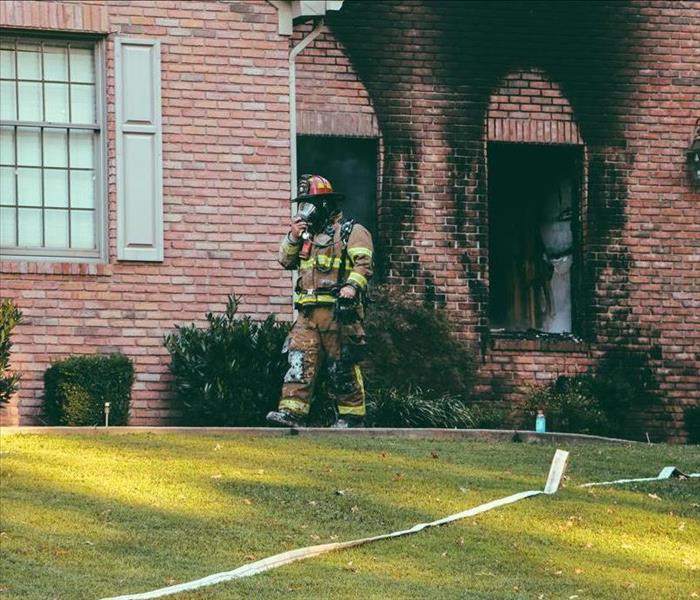How to Clean Up Smoke Damage in Your Home
7/31/2019 (Permalink)
Cleaning up smoke damage in your home is extremely important, but unfortunately, it won’t be as easy as opening a window and letting things air out. The acidic nature of smoke and soot makes them difficult to remove. However, they both contain unpleasant odors and particles that are harmful to breathe, so it’s important to clean them up completely to maintain a healthy living environment. Here at SERVPRO of South and North West Grand Rapids, we have years of fire damage clean-up experience, and over the years, we’ve picked up a few helpful tips that we’re sharing today:
What You’ll Need
One item you may have to buy is a dry-cleaning sponge, but many other helpful cleaning products can probably be found around your home. A sponge, however, is very important for smoke damage removal, so we encourage you not to neglect adding this effective cleaning tool to your list of supplies. We recommend you acquire the following:
- Rubbing alcohol/paint thinner
- Vinegar
- Degreaser / commercial soot remover
- Vacuum (ideally a strong shop-vac) with an upholstery attachment
- Bucket / hot water
- Dry-cleaning sponge (chemical sponge)
- Clean rags
- Sponge
- Fan
After obtaining the cleaning tools above, here are a few next steps:
Ventilate. The first thing you need to do is ventilate the house to get fresh air flowing; be sure to open all the doors and windows in the home. You also can use fans to encourage airflow. Additionally, turn off your HVAC system to prevent smoke and soot from spreading.
Use Protection. Before you clean your house, make sure to protect yourself properly. Soot, smoke, and debris can be dangerous to inhale, so wear a respirator if there is significant soot in the damaged area. Long pants and sleeves will protect your skin, and wearing gloves and eye protection can help save your eyes and hands. Since you will be freeing soot as you clean, it’s important to lay down floor protection and remove any furniture or household objects that are not damaged. If the damaged area is small, you can simply cover furniture with plastic or sheets, but if you’re cleaning an entire room, it’s wise to remove clean items and even seal off other rooms that were not affected. Be mindful of the shoes you’re wearing so you don’t track soot stains into other rooms.
Vacuum It Up. Soot and smoke damage usually come in one ugly, smelly package, so remove loose soot particles with a vacuum with an upholstery attachment. A shop-vac with strong suction power is best for this task. Lightly brush the affected area with the brush attachment, vacuuming up the loose particles. Be gentle and avoid scrubbing, which can make stains worse.
Use The Sponge. After performing the steps above, it’s time to use that dry-cleaning sponge (chemical sponge) to wipe up the soot and smoke stains; these sponges use special chemicals to lift stains from walls. Never use soot cleaner or water before you use a dry-cleaning sponge or you could spread the soot, making it impossible to remove with a chemical sponge. Begin by wiping the walls gently with the dry-cleaning sponge, and turn the sponge to a different side as it gets soiled so that you are always using a clean surface. When all sides are soiled, slice off the dirty sides with a knife to reveal fresh surfaces beneath, or use a new sponge. Make sure you use a wiping motion the entire time because when you scrub the stains, you spread them and work the soot deeper into the surface.
Use Liquid Cleaners. After you remove as much soot as possible with the dry-cleaning sponge, you can use commercial soot/smoke remover (follow the manufacturer’s directions), rubbing alcohol, white vinegar or paint thinner and a clean rag. Soak the rag in your preferred cleaner and wipe the walls throughout the damaged room. Even if there is no sign of soot or smoke damage, it’s important to wipe every surface in the room, including light bulbs. Next, you’ll want to use TSP, dish soap or degreaser in a gallon of hot water to wash the walls with a rag or sponge; just a few teaspoons should be enough. Use the same wiping motion you used with the dry-cleaning sponge. You may need to use a combination or repeated treatments of these chemical cleaners depending on how bad the damage is. As the rag gets dirty, rinse it out in the bucket or use a new rag. The same applies to your cleaning water. Refresh your water when it gets black or smells like smoke. Once you’ve completed washing the room with your chosen cleaner, wipe the walls again with fresh water and a clean rag to remove any remaining cleaning products.
Dry It Up. Dry the clean surfaces with a clean rag. You can use fans to speed this process up if necessary. You will probably still smell smoke odors, as they can take a few days to a few weeks to dissipate. Identify materials that can easily absorb odors, such as upholstered furniture or area rugs, and place these items together in a separate room or outdoors to see if the smell dissipates after a few days. You may want to consider throwing out the items you can stand to part with. Getting your carpeting, curtains, and furniture professionally cleaned will also help with lingering smoke odors. Don’t forget to replace your HVAC filters, which may be circulating smoky air in your home.
Cleaning your home after smoke or soot damage can be a difficult job. If you need assistance, SERVPRO of South and North West Grand Rapids is here to help. With IICRC-certified techniques and state-of-the-art equipment, our trustworthy experts are the best in the fire damage restoration industry.





 24/7 Emergency Service
24/7 Emergency Service
